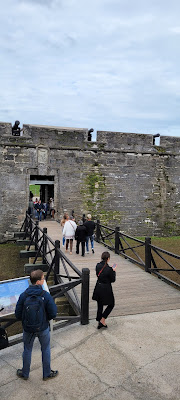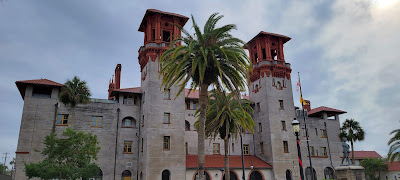Visited: Nov 2022
Nearby city: St. Augustine, FL
Castillo de San Marcos (St. Mark's Castle) is the oldest masonry fort in the country. The fort is located in the town of St. Augustine, Florida. Founded in 1565, St. Augustine is the oldest continuously inhabited European settlement in what is now the United States. The town was founded by the Spanish conquistador Pedro Menendez de Aviles and served as the capital of Spanish Florida for over 200 years.
St. Augustine was sacked and nearly destroyed by English privateer Robert Searle in 1668. After the raid, Governor Francisco de la Guerra y de la Vega ordered that a mason fort be constructed in order to protect the city. Construction began in 1672 and was eventually completed in 1695. The fort sits on the coast where the Matanzas River empties into the Atlantic Ocean. This was a prime spot to guard against attacks by pirates.
In 1670, English colonists founded Charleston (in present-day South Carolina). Charleston was only a two day's sail from St. Augustine and conflict over land claims between the Spanish Empire and the British Empire inevitably broke out. Additionally, slaves from the Carolina Colony would escape to St. Augustine, where the Spanish authorities agreed to free (and employ) them if they converted to Catholicism. In 1702, the governor of Carolina Colony, James Moore, led an expedition in an attempt to conquer and occupy St. Augustine. Moore's army laid seige to the town for over two months, but failed to capture the fort. The fort's thick walls stood strong against the English cannon and Moore's army retreated back to Carolina. The fort again defended the town in 1740, when the founder and Governor of the Colony of Georgia, James Oglethorpe, led an unsuccessful attempt to conquer the city.
At the conclusion of the Seven Years' War and the signing of the Treaty of Paris (1763), Spain ceded Spanish Florida to Britain in exchange for Britain returning the ports of Havana (in Cuba) and Manila (in the Philippines) to Spain. The fort was under British control for approximately twenty years. But then under the terms of the Treaty of Paris (1783), which ended the American Revolution, Britain returned Florida to the Spanish Empire.
The Spanish Empire and the newly-formed United States of America would quibble over the boundary between the two countries over the years. However, the gradual decline of the Spanish Empire in the early 19th century and violent revolutions in Mexico and its other colonies in Central and South America, led Spanish authorities to agree to cede Florida to the USA as terms of the Adams-Onis Treaty in 1821.
The fort (renamed by the Americans as Fort Marion) served as a military installation until 1933 - except for a brief period when the Union Army abandoned the fort early in the Civil War. In 1933, the fort was transferred to the National Park Service.
When we visited, we were lucky to observe a cannon firing demonstration. It was really cool.
Tara with a cannoneer in traditional uniform
Take a tour of the building, there are lots of exhibits to learn all about life at the fort. There's also lots of antique cannons on display.
The fortress walls were built with coquina (Spanish for "small shells"). Coquina consists of ancient shells that have bonded together to form a sedimentary rock similar to limestone. These strong walls were nearly imprenetrable against cannon attack. Instead of shattering, the walls would compress and absorb the shot. Cannonballs would either bounce off, or only sink in the walls a few inches. This unique material became known as the "rock that saved St. Augustine."
the emblem flying over the fort is the historical flag of the Spanish Empire.
Known as the "Cross of Burgundy"
the shape of the Castillo de San Marcos is a "star fort"
the city crest of St. Augustine
close up of the coquina walls. See all the shells?
The moat surrounding the fort was usually kept dry. But could be flooded with about a foot of water in case of an attack by land.
this structure is a furnace to make "heated shot"
Heating a cannonball before firing was used to set ships and buildings ablaze.
For more info: https://www.nps.gov/casa/index.htm
St. Augustine is an interesting, unique town full of historical buildings. We explored the town. St. Augustine is famous for its Christmas displays.
The historic Hotel Alcazar was built by industrialist Henry Flagler in 1887. Flagler was co-founder of Standard Oil with John D. Rockefeller. Flagler also built the Florida East Coast Railway, which was instrumental in the development of Florida to the vacation and retirement destination that it is today.
Hotel Alcazar now houses the Lightner Museum.
statue of the founder of St. Augustine, Pedro Menendez de Aviles
beautiful Flagler College, a private liberal arts college.
The main building on campus is the former Ponce de Leon Hotel, built in 1888 by Flagler.
inside the historic Ponce de Leon hotel
the historic city wall
the Atlantic Ocean
We had a great time in the beautiful historic town of St. Augustine.





























































































No comments:
Post a Comment